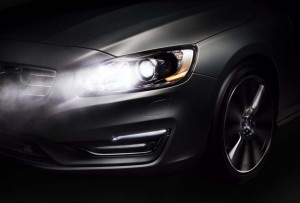New technology has become as important to motorists as new cars, it seems, and Volvo is one of several makers who plan to focus on high-tech breakthroughs during the upcoming Geneva Motor Show, the Swedish maker switching on its new Active High Beam headlamp system.
To be offered on its S60, V60 and XC60 models, the Active High Beam Control technology will allow motorists to leave their brights on at all times, using a novel, high-tech approach to avoid blinding other drivers.
So far, that may not sound so unique. As far back as the 1960s, some luxury cars were equipped with primitive light sensors that were intended to detect the lights of oncoming vehicles and automatically dim the vehicle’s headlamps. Similar technology has become relatively common today.
But instead of switching back to low beams, which means far less visibility on back roads or moonless nights, Volvo’s new system doesn’t dim its headlamps. Instead, it automatically blocks out a portion of the high beam to prevent it from blinding other drivers.
“The technology makes driving at night more comfortable and safe. It also makes it easier to focus on the driving and is an excellent example of our Designed Around You approach, always focusing on features that really make a difference to the customer,” says Lotta Jakobsson, a senior technical specialist at the Volvo Cars Safety Center.
The Active High Beam systems uses a camera that’s already in place on those Volvo models for several other safety systems, including one that can bring the vehicle to a sudden halt if, for example, a pedestrian walks into its path.
If it spots an approaching car – or the tail lamps of a vehicle too close ahead – a control unit signal the projector headlamp module and a tiny cylinder with various metal pieces slides in place, essentially focusing the bright beams out of the other driver’s eyes. The technology can be used at speeds as low as about 9 mph, Volvo says.
The Active High Beam system is expected to go into production this coming spring. For the moment, however, don’t expect to see it in the U.S. It doesn’t comply with current American headlamp standards, though Volvo is one of several makers pressing for more flexibility in the U.S. Federal Motor Vehicle Safety Standard, or FMVSS, code to permit creative, high-tech lighting solutions found in Europe and other parts of the world.

